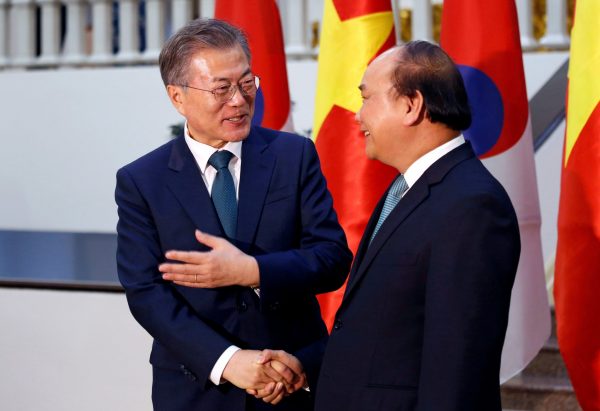Vietnam has long been South Korea’s largest economic partner in Southeast Asia. Despite the diplomatically problematic history of South Korea’s anti-communist intervention in the Vietnam War, bilateral ties rapidly expanded after diplomatic normalisation in 1992. The relationship deepened even more after the two countries signed a free trade agreement in December 2015. Moon and Vietnamese President Tran Dai Quang agreed to increase their countries’ bilateral trade to US$100 billion by 2020 — double the 2017 figure.
Beyond advancing South Korea’s economic interests, Moon’s visit to Vietnam sends a signal that Seoul seeks a strong and relatively independent geopolitical role in the region despite the constraints of Seoul’s military alliance with the United States and its economic dependence on China. China will remain South Korea’s largest economic partner for the foreseeable future, but by cultivating close political, economic and cultural ties with smaller countries on China’s periphery — especially independent-minded countries like Vietnam that are suspicious of China’s hegemonic ambitions — South Korea can help mitigate unilateral Chinese dominance of the Asia Pacific region. Vietnam is also historically close to North Korea, and close ties with Hanoi can help South Korea deal productively with Pyongyang.
This pursuit of a more independent-minded diplomacy is even more evident in Moon’s visit to the UAE — South Korea’s second-largest trading partner in the Middle East and the residence of more than half of the 25,000 South Koreans in the region. South Korea, which has long relied on imported oil from the Middle East, has invested heavily in the Middle East’s construction industry since the 1970s and has sent thousands of South Korean workers to the region. South Korea’s first nuclear technology exports — the South Korean-built Barakah nuclear reactors — are set to go online this year in the UAE. The Barakah reactors will be the first nuclear power plants on the Arabian Peninsula.
For better or worse, South Korea is now committed to a security role in the Gulf region as well. South Korea has had a military presence in the greater Middle East through much of the 21st century: it sent troops to assist the US-led interventions in Afghanistan and Iraq as well as to the UAE itself in 2011. President Moon and the Crown Prince of Abu Dhabi agreed on this trip to a ‘special strategic partnership’, which apparently entails potential South Korean military intervention under extreme circumstances.
South Korea has developed an economic and security interest that is drawing the country into the vexing politics of the Middle East. Its growing presence in the region suggests that Moon wants his country to be an independent player in the Middle East, in part to compete with China and Japan’s expanding interests there.
This Middle East role in turn reflects South Korea’s longstanding pursuit of both soft and hard power in its foreign affairs. Moon is following in the footsteps of his mentor, former president Roh Moo-hyun, whose administration promoted South Korea as a ‘balancer’ in regional and global politics. Moon has studiously avoided this term, since some South Koreans as well as members of the George W Bush administration saw it as undermining the US–South Korea alliance. But outside this rhetorical avoidance, Moon’s diplomatic direction is very much in line with former president Roh’s, while his administration is careful to articulate these goals in a way that does not antagonise China or the United States.
Using the imagery of Roh’s advisor Bae Ki-chan, South Korea’s goal is to no longer be a ‘shrimp among whales’ that is crushed by the geopolitical interests of the surrounding great powers but to be instead an agile and intelligent ‘dolphin’. Whether Moon can succeed in this task remains to be seen, but under his leadership South Korea appears intent on establishing a stronger and more visible presence in the world.
Charles K Armstrong is The Korea Foundation Professor of Korean Studies in the Social Sciences at Columbia University and author of The Koreas.

